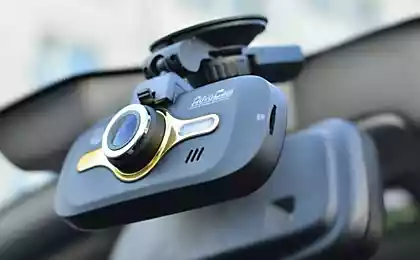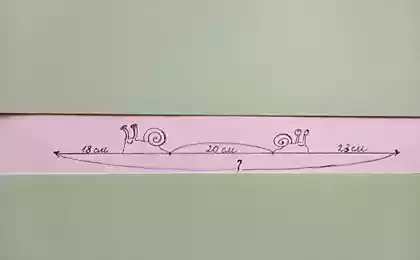1239
Mi-Mi-Mi
As the name implies, it will focus on the site today with canned helicopters in the Leningrad region. For storage allocated a large section of the runway of the airfield. Helicopters GDP is not enough - more than six dozen. To iron birds are not taken away for scrap site was fenced with mesh netting at both ends set guard dogs. Since the whole thing is located on a former airfield all the space is easily visible, thereby a security guard might have noticed on the approach. But we were lucky valiant guard was busy repairing the car and did not notice anything, and his faithful dog could not smell us, as we were downwind, the wind was blowing almost constantly. Reaching short dashes to the site, we quietly slipped under the net. Due to the fact that the helicopters are standing in neat rows, being in line with them, we become completely invisible to the protection and you can safely take pictures.
33 photos + text
via saoirse
01. Helicopters standing on the preservation divided into two rows, one MI-24 are, in the other MI-8. With the latter, I'll start.
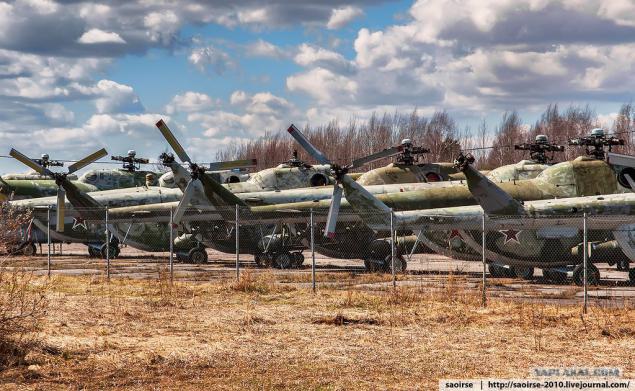
02. To get started is to tell the history of the origins of this magnificent machine. At the end of the 50s Mikhail Mil seeing the advantage of foreign helicopter turbine engines, proposed the creation of a new car to replace the Mi-4 with a piston powerplant. But this was refused, the country's leaders do not want to change the well-functioning of large-series production of the Mi-4. Miles then went to a small trick, proposing to create not new helicopter, but only to modify the old.

03. The ruse worked, and in 1958 the project approved. Future helicopter was called "V-8." Client machines became the Ministry of Civil Aviation. Since the project was officially upgrading the Mi-4, to make major changes is not possible. A prototype based on the Mi-4 with one engine on the roof, with a modernized helicopter used by aircraft engines. At that time, the Soviet helicopter gas turbine power unit did not exist even in the projects.
The first prototype of the V-8
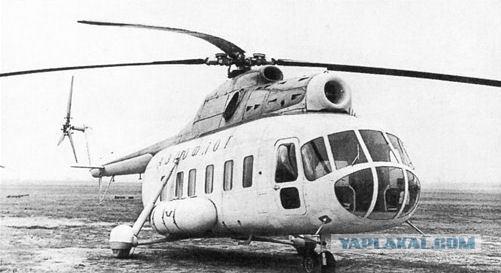
04. Despite the fact that work on the V-8 helicopter was in full swing, Michael Mile wanted to realize the project of a twin-engine helicopter and this possibility was soon given the surprisingly thanks to the Americans. In 1959, Nikita Khrushchev arrived on an official visit to the US, where his ride on a government helicopter S-58 developed by Russian engineer Igor Sikorsky in immigration. Helicopter impressed him the head of the Soviet Union and naturally wanted to, something like that, the more we plan a return visit to the US president in the USSR. Upon returning back to the country, Khrushchev showed B-8, and then Miles decided to risk putting forward its proposal for Double Motor helicopter, referring to the fact that this design safer and more comfortable. The moment has been chosen correctly and in May 1960 issued a decree of the Council of Ministers of the USSR on the development of a helicopter with two turbine power plants based on the V-8.
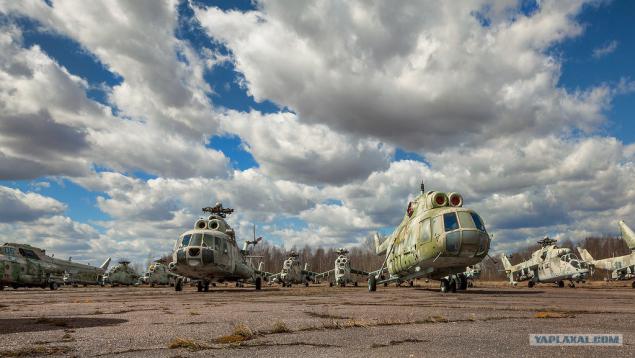
05. Having received the go-ahead for the creation of a new car there is the biggest challenge - helicopter turbine engine. Most of the construction department did not want to mess with this difficult task, except for the OKB-117 under the leadership of Sergey P. Izotov, who happily took up the matter, apparently realizing the prospects of this type of engine. Stand still and wait until the engine will create Miles was not going to, so it was decided to set up five experimental machines, where the first two are single modified aircraft engines AI-24B, and three cars with two engines from the OKB SP Izotov, which should by that time to collect power units.

06. In the summer of 1961 the first prototype was ready in 8-June 24, he first took to the air, and two weeks later it was shown to the public at aviaparada in Tushino. In the autumn of the same year it was made the second car with a single engine. A year later, EDO SP Izotov provided the first copies TV2-117s engine, which proved to be more powerful than it was planned. Because of this, it was necessary to make some changes in the transmission of the helicopter, as well as make new gearbox that was again tasked OKB SP Izotov. For comparison, the AI-24B had a capacity of 1900 hp and the new TV2-117s - 1500 hp, but we must not forget that they put two. The engines and the new three-step planetary gear BP-8 installed on the second prototype, which received a new index-8A. Already August 2, 1962 he first took to the air.
The second prototype of the V-8A
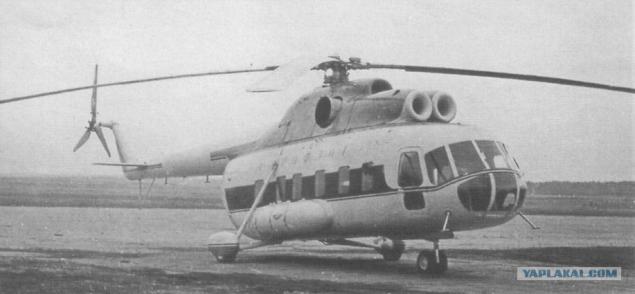
07. In the course of testing the V-8A was constantly rework parts. All changes were made in the third prototype of the V-8AT, who at the request of the State was carried out in the military troop performance. No changes have been many, I will note just a few: to reduce vibration and improve flight performance has been added to another blade in the rotor; changed side doors and side doors of the crew in the cargo bay, they began sliding; It sets a new autopilot; We set a new thermoelectric power anti-icing system; replaced depreciation chassis; Engines equipped with an automatic control system that is synchronized engine and supported rotor speed, in case of failure of one engine, it automatically increases power remaining to continue the flight. In the summer of 1963-8AT he was ready for flight and ground endurance test. During the test, April 19, 1964 the crew of a test pilot V.Koloshenko found on B-8AT two world records: distance record for a closed route (2465, 7 km) and the speed record on the basis of 2,000 kilometers (201, 8 km / h) . In May 1964 it was compiled 4th prototype V-8AP in the embodiment of government helicopter that showed the top of government. The helicopter they liked, and in November 1964 passenger and military-landing variant recommended to start in the series. The fifth prototype became the benchmark for mass production of it was made in the passenger version. At the end of 1965 from the Kazan plant plants came first serial Mi-8P. In the same year showed the helicopter at an air show in Paris, where he received high scores and was recognized as one of the best helicopters in the world of the middle class.
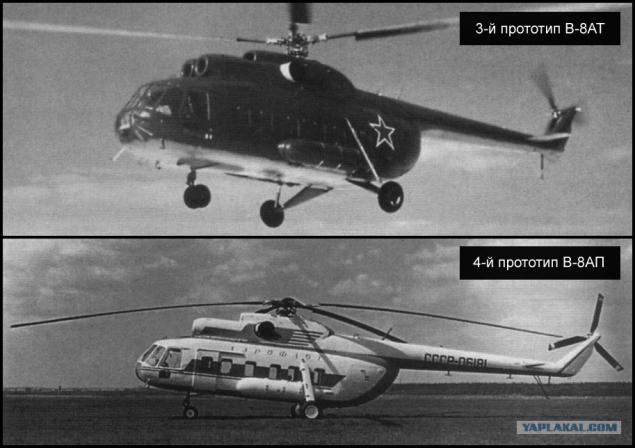
08. Despite the obvious advantages of the Mi-8 Mi-4 military were in no hurry to move to a new car. The turning point was the war in Vietnam. Seeing how well the Americans are using modern helicopters, the Soviet military officials asked as soon as possible to establish mass production of amphibious transport version of the MI-8. In 1968, after passing all the tests, he was adopted by the Soviet Army and was named Mi-8T.
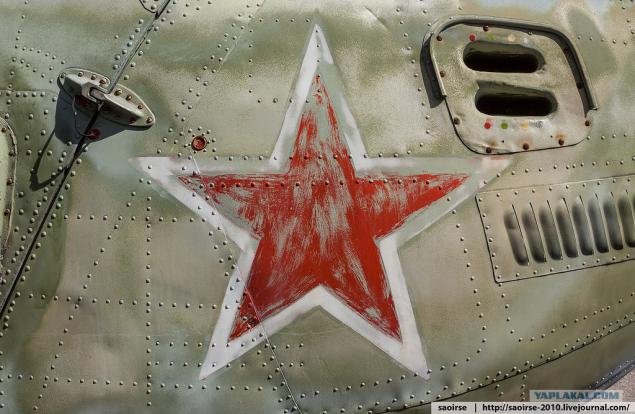
09. The next significant event in the history of the Mi-8 was updated powerplant TV2-117s new TV3-117 engines with a capacity of 1,900 liters. from. This engine was developed CB Izotova in the mid 60-ies of the last century version amphibious helicopter based on the Mi-8. In addition to the new engine was replaced in the modification of the transmission gear, there auxiliary power unit AI-9 with a starter-generator and the tail rotor began to reverse rotation, which improved handling. Since the beginning of the work to start serial production took 10 years. In 1977 was released the first update of MI-8T, Mi-received index 8Mt. At first orders for the new version was a little preference for the military surrendered the old version, but everything changed with the beginning of the war in Afghanistan, where was the best technique required. Toward the end of the war MI-8MT has become the main assembly lines.

10. After updating the mid 70s was followed by two more upgrades in the mid 80s - MI-8 MTV (high-altitude version that could take off and land at an altitude of 4000 meters and fly at altitudes up to 6000 m.) And in the mid-90 -x - MI-8MTKO (hour version). One of the main advantages of the helicopter MI-8 as a whole, it can be considered universal design, thanks to which it was issued more than a hundred modifications for different purposes, both civilian and military.

11. Since at the site is a lot of military helicopters EW of these modifications probably worth discussing in detail.

12. With the emergence of armed Soviet helicopter MI-8T was possible to install them at the station full electronic countermeasures. With the help of these devices are interfering on the radar screen of detection, which makes it difficult to define the range of the helicopter and cover them air technology group, thereby complicating the guidance and ongoing maintenance purpose. The first helicopter - jammers appeared in the 70s of the last century.

13. The photo MI-8PPA reduction means PP - jammer, and the letter "A" - the first letter of the name of the main station, which is used by helicopter to interfere in our case - "Azalea." The rectangular box on which the antenna is drawn star jamming station SPS-63 (66), which just refers to "Azaleas».
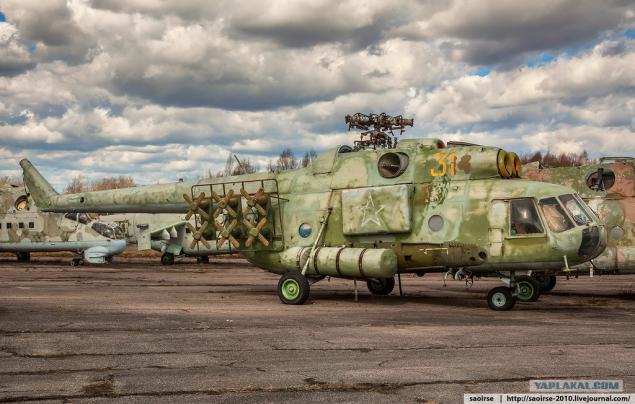
14. Often in the MI-8PPA put further jamming station SPS-5M2 "Beans."

15. Apparently bean name of the station gave a dipole antenna, which has some similarities with flowers beans.
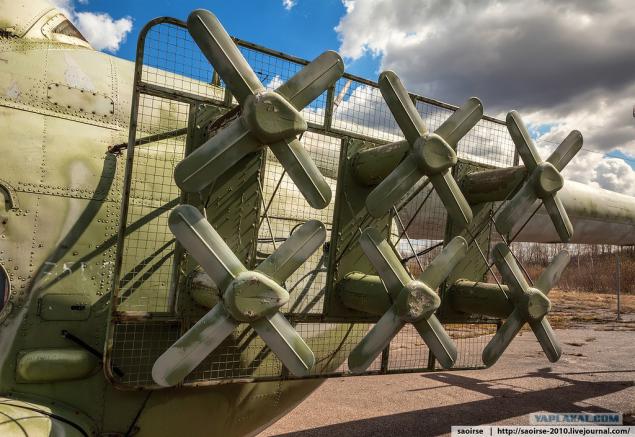
16. The antennas are mounted on both sides.

17.

18. If you look at the bottom of the helicopter, you can see the oil-air radiator cooling system EW plants.
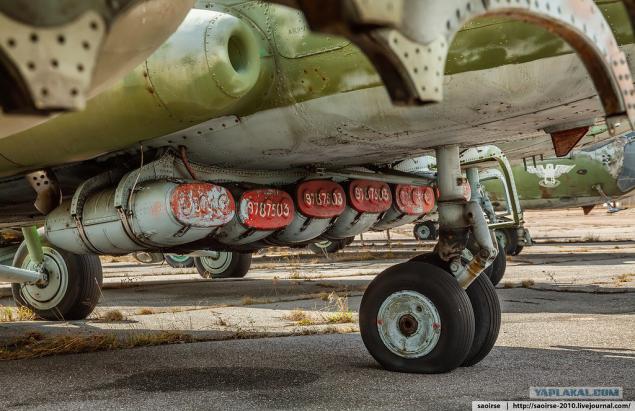
19. Mi-8PPA not only helicopters, jammers on this site. On conservation helicopters are the first modification of electronic warfare - Mi-8SMV first appeared in 1971. The name of the helicopter was due to set it jamming system "Smalt-V." The main objective of this complex was to create interference for US air defense system "Hawk."
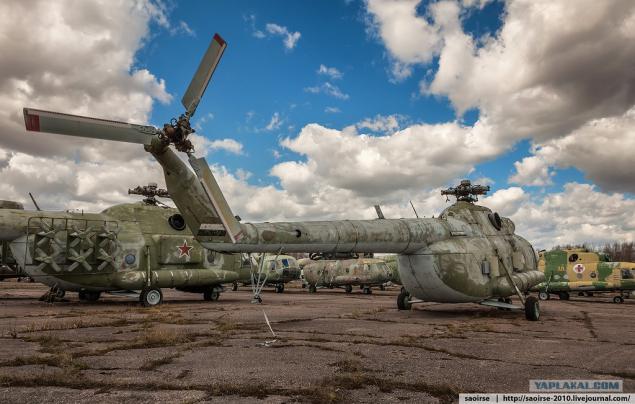
20. The first made in the 70s, it was decided to test the samples in a real combat situation. For this complex "Smalt-V" was installed in the Bekaa Valley in the Middle East where there was an Israeli air defense system, "Hok", which covered the valley from Arab attack aircraft. As soon as the launch of missiles on the plane, includes a set of operators and issued missiles are beginning to change the path, and either fell to the ground, or self-destructed exceeding the maximum distance control. It should be noted that the established in the valley of the complex was a car, not a helicopter, but installed on the Mi-8 system interference "Smalt-V" were no less effective.
Helicopter right - Mi-8SMV
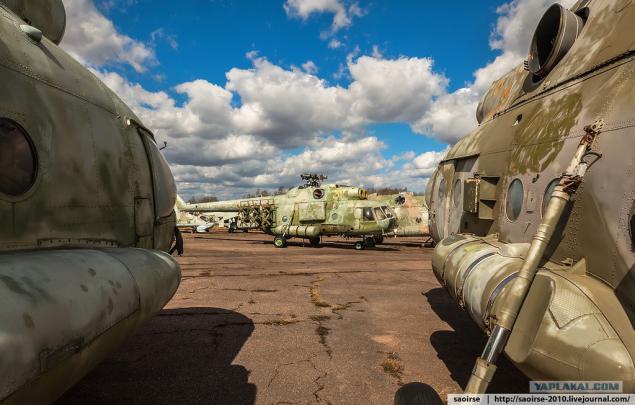
21. Small squares set on a par with portholes this station antenna EW "Smalt-V."
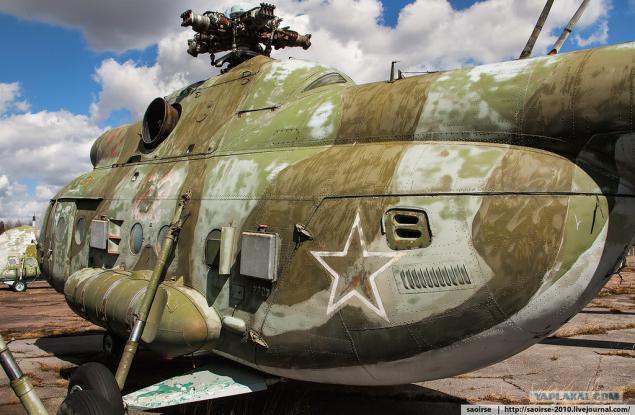
22. With this jammer nearly all removed, but on the roof of the fuselage of the helicopter, you can see the item is similar to the green socket incandescent bulbs - a light thermal noise SOEP-B1A "Linden." It is designed to protect the unit from infrared-guided missiles, supposedly the ones that start with man-portable air defense systems (MANPADS).

23. In total, there are two types of protection of helicopters from infrared-guided missiles. Lamp that in the photo above and the device is reset false thermal purposes, which can be seen on the side of the sanitary helicopter next to the star. This unit on each side of the beam are shooting traps ASO-2B. The principle of the protection plan is quite simple, when the missile flies in a helicopter, ASO-2B shoots pyrotechnic devices that emit large amounts of heat, and thus withdraws from the rocket itself.

24. At the bottom of the tail boom can be seen a rectangular box - a Doppler velocity and drift (Diss) radar, automatic continuous measurement and display components of the velocity vector, the module ground speed, drift angle and the coordinates of the location of the helicopter alone or in combination with navigation equipment .

25. One of the most important elements of the helicopter without which it would be unmanageable - swash plate. The principle of operation of this machine is very simple. Each blade propeller describes a circle in rotation. If the rotor blades made movable relative to their longitudinal axes, so that they can change the angle to the plane of rotation, it is very easy to control the motion of the helicopter. Just in helicopter design scheme uses two swash: St. George's and Sikorsky, which though have external differences, but the principle of operation is identical. On the Mi-8 helicopter of the Russian scientist used a scheme BN St. George, which he invented in 1911

26. In the beginning, I said that these helicopters are on the preservation, but I got the impression that they are intended to parse for parts. As an example, the Mi-8T has lost the end of the beam, fuel tanks, rotor swash plate and it is only at first glance.

27. Some helicopters can see the logos of various small animals. In the photo above - the polar bear, and MI-8MT below, shows the snowy owl. Rather, they are drawn not just, but to find some information on these emblems I could not.
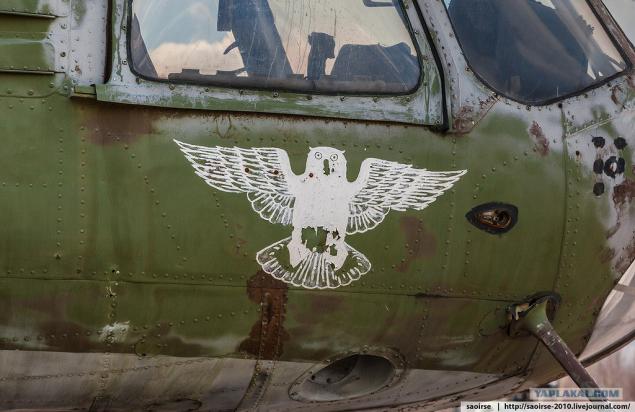
28. Another difference between the MI and MI-8T-8Mt this increase in the number of holders on the lateral beam farms, housed in an updated version of the already three rather than two as previously. Thus, the helicopter could pick up even more weapons.

29.
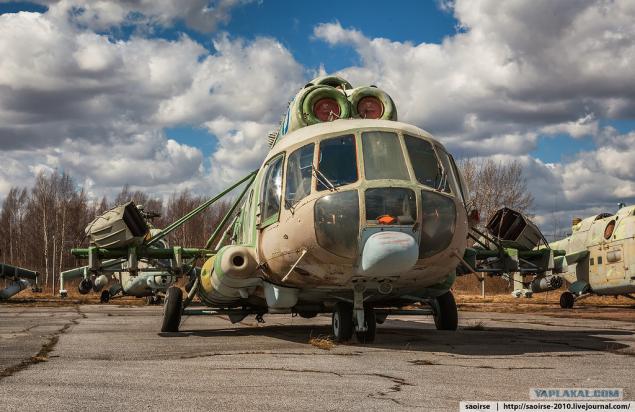
30. In addition to the universal design of the MI-8 helicopter has the popularity of its influence and its dimension. It is of this size and class of the most popular helicopters in the world. Not surprisingly, these helicopters are eagerly bought by different countries. At the time of 2012 MI-8 in various versions have been sold in 93 countries around the world.
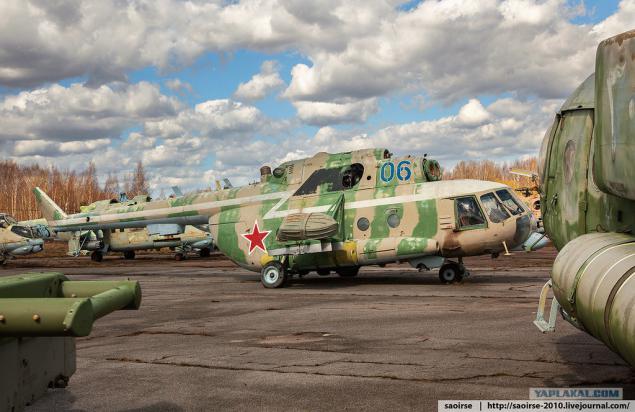
31. With the advent in the mid 70-ies MI-8MT its export version is called MI-17, modern versions for delivery in other countries have the same name. For example MI-8 MTV-1 in the export variation called Mi-17-1B.
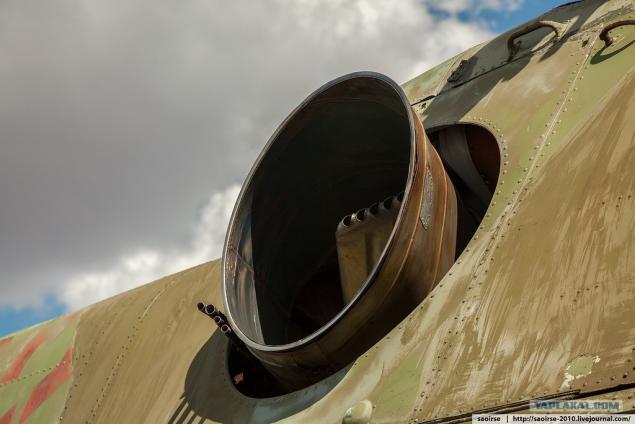
32. In just over 50-year history of the helicopter Mi-8 was released more than 12 000 copies, which made the helicopter is not only the most massive twin-engined helicopter in the USSR and Russia, but also throughout the world.
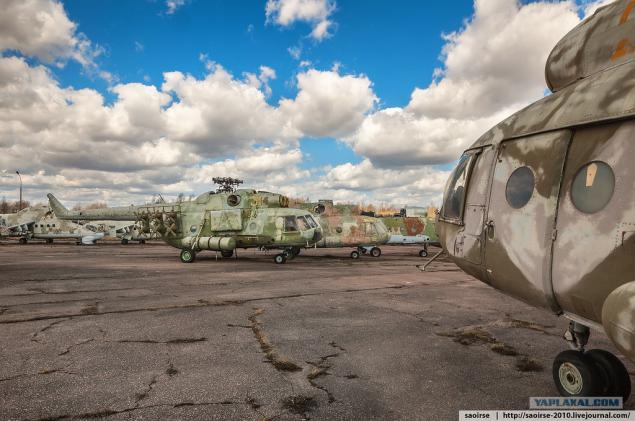
33. This concludes with canned Mi-8 helicopter in the Leningrad region. Next time we will focus on the Mi-24, so to be continued ...
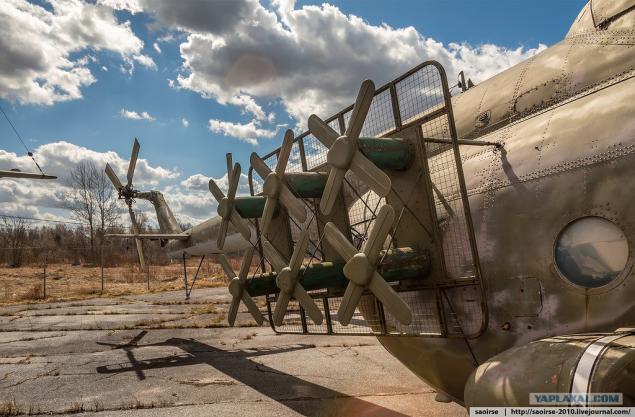
Source:
33 photos + text
via saoirse
01. Helicopters standing on the preservation divided into two rows, one MI-24 are, in the other MI-8. With the latter, I'll start.

02. To get started is to tell the history of the origins of this magnificent machine. At the end of the 50s Mikhail Mil seeing the advantage of foreign helicopter turbine engines, proposed the creation of a new car to replace the Mi-4 with a piston powerplant. But this was refused, the country's leaders do not want to change the well-functioning of large-series production of the Mi-4. Miles then went to a small trick, proposing to create not new helicopter, but only to modify the old.

03. The ruse worked, and in 1958 the project approved. Future helicopter was called "V-8." Client machines became the Ministry of Civil Aviation. Since the project was officially upgrading the Mi-4, to make major changes is not possible. A prototype based on the Mi-4 with one engine on the roof, with a modernized helicopter used by aircraft engines. At that time, the Soviet helicopter gas turbine power unit did not exist even in the projects.
The first prototype of the V-8

04. Despite the fact that work on the V-8 helicopter was in full swing, Michael Mile wanted to realize the project of a twin-engine helicopter and this possibility was soon given the surprisingly thanks to the Americans. In 1959, Nikita Khrushchev arrived on an official visit to the US, where his ride on a government helicopter S-58 developed by Russian engineer Igor Sikorsky in immigration. Helicopter impressed him the head of the Soviet Union and naturally wanted to, something like that, the more we plan a return visit to the US president in the USSR. Upon returning back to the country, Khrushchev showed B-8, and then Miles decided to risk putting forward its proposal for Double Motor helicopter, referring to the fact that this design safer and more comfortable. The moment has been chosen correctly and in May 1960 issued a decree of the Council of Ministers of the USSR on the development of a helicopter with two turbine power plants based on the V-8.

05. Having received the go-ahead for the creation of a new car there is the biggest challenge - helicopter turbine engine. Most of the construction department did not want to mess with this difficult task, except for the OKB-117 under the leadership of Sergey P. Izotov, who happily took up the matter, apparently realizing the prospects of this type of engine. Stand still and wait until the engine will create Miles was not going to, so it was decided to set up five experimental machines, where the first two are single modified aircraft engines AI-24B, and three cars with two engines from the OKB SP Izotov, which should by that time to collect power units.

06. In the summer of 1961 the first prototype was ready in 8-June 24, he first took to the air, and two weeks later it was shown to the public at aviaparada in Tushino. In the autumn of the same year it was made the second car with a single engine. A year later, EDO SP Izotov provided the first copies TV2-117s engine, which proved to be more powerful than it was planned. Because of this, it was necessary to make some changes in the transmission of the helicopter, as well as make new gearbox that was again tasked OKB SP Izotov. For comparison, the AI-24B had a capacity of 1900 hp and the new TV2-117s - 1500 hp, but we must not forget that they put two. The engines and the new three-step planetary gear BP-8 installed on the second prototype, which received a new index-8A. Already August 2, 1962 he first took to the air.
The second prototype of the V-8A

07. In the course of testing the V-8A was constantly rework parts. All changes were made in the third prototype of the V-8AT, who at the request of the State was carried out in the military troop performance. No changes have been many, I will note just a few: to reduce vibration and improve flight performance has been added to another blade in the rotor; changed side doors and side doors of the crew in the cargo bay, they began sliding; It sets a new autopilot; We set a new thermoelectric power anti-icing system; replaced depreciation chassis; Engines equipped with an automatic control system that is synchronized engine and supported rotor speed, in case of failure of one engine, it automatically increases power remaining to continue the flight. In the summer of 1963-8AT he was ready for flight and ground endurance test. During the test, April 19, 1964 the crew of a test pilot V.Koloshenko found on B-8AT two world records: distance record for a closed route (2465, 7 km) and the speed record on the basis of 2,000 kilometers (201, 8 km / h) . In May 1964 it was compiled 4th prototype V-8AP in the embodiment of government helicopter that showed the top of government. The helicopter they liked, and in November 1964 passenger and military-landing variant recommended to start in the series. The fifth prototype became the benchmark for mass production of it was made in the passenger version. At the end of 1965 from the Kazan plant plants came first serial Mi-8P. In the same year showed the helicopter at an air show in Paris, where he received high scores and was recognized as one of the best helicopters in the world of the middle class.

08. Despite the obvious advantages of the Mi-8 Mi-4 military were in no hurry to move to a new car. The turning point was the war in Vietnam. Seeing how well the Americans are using modern helicopters, the Soviet military officials asked as soon as possible to establish mass production of amphibious transport version of the MI-8. In 1968, after passing all the tests, he was adopted by the Soviet Army and was named Mi-8T.

09. The next significant event in the history of the Mi-8 was updated powerplant TV2-117s new TV3-117 engines with a capacity of 1,900 liters. from. This engine was developed CB Izotova in the mid 60-ies of the last century version amphibious helicopter based on the Mi-8. In addition to the new engine was replaced in the modification of the transmission gear, there auxiliary power unit AI-9 with a starter-generator and the tail rotor began to reverse rotation, which improved handling. Since the beginning of the work to start serial production took 10 years. In 1977 was released the first update of MI-8T, Mi-received index 8Mt. At first orders for the new version was a little preference for the military surrendered the old version, but everything changed with the beginning of the war in Afghanistan, where was the best technique required. Toward the end of the war MI-8MT has become the main assembly lines.

10. After updating the mid 70s was followed by two more upgrades in the mid 80s - MI-8 MTV (high-altitude version that could take off and land at an altitude of 4000 meters and fly at altitudes up to 6000 m.) And in the mid-90 -x - MI-8MTKO (hour version). One of the main advantages of the helicopter MI-8 as a whole, it can be considered universal design, thanks to which it was issued more than a hundred modifications for different purposes, both civilian and military.

11. Since at the site is a lot of military helicopters EW of these modifications probably worth discussing in detail.

12. With the emergence of armed Soviet helicopter MI-8T was possible to install them at the station full electronic countermeasures. With the help of these devices are interfering on the radar screen of detection, which makes it difficult to define the range of the helicopter and cover them air technology group, thereby complicating the guidance and ongoing maintenance purpose. The first helicopter - jammers appeared in the 70s of the last century.

13. The photo MI-8PPA reduction means PP - jammer, and the letter "A" - the first letter of the name of the main station, which is used by helicopter to interfere in our case - "Azalea." The rectangular box on which the antenna is drawn star jamming station SPS-63 (66), which just refers to "Azaleas».

14. Often in the MI-8PPA put further jamming station SPS-5M2 "Beans."

15. Apparently bean name of the station gave a dipole antenna, which has some similarities with flowers beans.

16. The antennas are mounted on both sides.

17.

18. If you look at the bottom of the helicopter, you can see the oil-air radiator cooling system EW plants.

19. Mi-8PPA not only helicopters, jammers on this site. On conservation helicopters are the first modification of electronic warfare - Mi-8SMV first appeared in 1971. The name of the helicopter was due to set it jamming system "Smalt-V." The main objective of this complex was to create interference for US air defense system "Hawk."

20. The first made in the 70s, it was decided to test the samples in a real combat situation. For this complex "Smalt-V" was installed in the Bekaa Valley in the Middle East where there was an Israeli air defense system, "Hok", which covered the valley from Arab attack aircraft. As soon as the launch of missiles on the plane, includes a set of operators and issued missiles are beginning to change the path, and either fell to the ground, or self-destructed exceeding the maximum distance control. It should be noted that the established in the valley of the complex was a car, not a helicopter, but installed on the Mi-8 system interference "Smalt-V" were no less effective.
Helicopter right - Mi-8SMV

21. Small squares set on a par with portholes this station antenna EW "Smalt-V."

22. With this jammer nearly all removed, but on the roof of the fuselage of the helicopter, you can see the item is similar to the green socket incandescent bulbs - a light thermal noise SOEP-B1A "Linden." It is designed to protect the unit from infrared-guided missiles, supposedly the ones that start with man-portable air defense systems (MANPADS).

23. In total, there are two types of protection of helicopters from infrared-guided missiles. Lamp that in the photo above and the device is reset false thermal purposes, which can be seen on the side of the sanitary helicopter next to the star. This unit on each side of the beam are shooting traps ASO-2B. The principle of the protection plan is quite simple, when the missile flies in a helicopter, ASO-2B shoots pyrotechnic devices that emit large amounts of heat, and thus withdraws from the rocket itself.

24. At the bottom of the tail boom can be seen a rectangular box - a Doppler velocity and drift (Diss) radar, automatic continuous measurement and display components of the velocity vector, the module ground speed, drift angle and the coordinates of the location of the helicopter alone or in combination with navigation equipment .

25. One of the most important elements of the helicopter without which it would be unmanageable - swash plate. The principle of operation of this machine is very simple. Each blade propeller describes a circle in rotation. If the rotor blades made movable relative to their longitudinal axes, so that they can change the angle to the plane of rotation, it is very easy to control the motion of the helicopter. Just in helicopter design scheme uses two swash: St. George's and Sikorsky, which though have external differences, but the principle of operation is identical. On the Mi-8 helicopter of the Russian scientist used a scheme BN St. George, which he invented in 1911

26. In the beginning, I said that these helicopters are on the preservation, but I got the impression that they are intended to parse for parts. As an example, the Mi-8T has lost the end of the beam, fuel tanks, rotor swash plate and it is only at first glance.

27. Some helicopters can see the logos of various small animals. In the photo above - the polar bear, and MI-8MT below, shows the snowy owl. Rather, they are drawn not just, but to find some information on these emblems I could not.

28. Another difference between the MI and MI-8T-8Mt this increase in the number of holders on the lateral beam farms, housed in an updated version of the already three rather than two as previously. Thus, the helicopter could pick up even more weapons.

29.

30. In addition to the universal design of the MI-8 helicopter has the popularity of its influence and its dimension. It is of this size and class of the most popular helicopters in the world. Not surprisingly, these helicopters are eagerly bought by different countries. At the time of 2012 MI-8 in various versions have been sold in 93 countries around the world.

31. With the advent in the mid 70-ies MI-8MT its export version is called MI-17, modern versions for delivery in other countries have the same name. For example MI-8 MTV-1 in the export variation called Mi-17-1B.

32. In just over 50-year history of the helicopter Mi-8 was released more than 12 000 copies, which made the helicopter is not only the most massive twin-engined helicopter in the USSR and Russia, but also throughout the world.

33. This concludes with canned Mi-8 helicopter in the Leningrad region. Next time we will focus on the Mi-24, so to be continued ...

Source:












